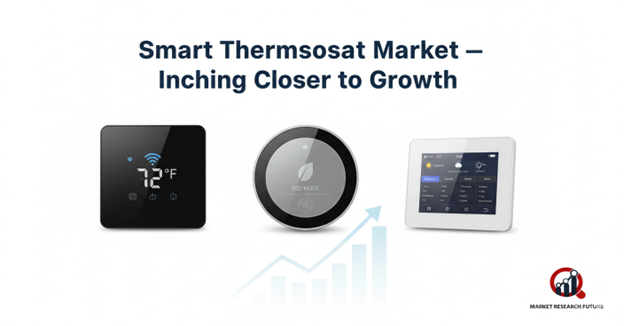Smart Thermostat: Inching Closer to Growth

Smart Thermostat Market Overview
The global shift toward smart homes and energy-efficient living is driving significant growth in the smart thermostat market. Smart thermostats, designed to intelligently control indoor temperature, are redefining how consumers manage energy consumption and comfort. By learning user behavior and optimizing heating or cooling schedules, these devices not only enhance convenience but also reduce energy waste and operational costs.
According to market estimates, the global smart thermostat market is expected to witness robust growth through 2030, supported by increasing smart home adoption, government initiatives promoting energy efficiency, and technological advancements in wireless connectivity and AI integration.
What is a Smart Thermostat?
A smart thermostat is an advanced home device that automatically adjusts indoor temperature based on user preferences, occupancy patterns, and external conditions. These thermostats can be controlled remotely through mobile apps, voice assistants, or connected home systems, offering real-time monitoring and adaptive functionality.
Unlike traditional thermostats, smart variants leverage sensors, Wi-Fi connectivity, and machine learning algorithms to analyze data, predict temperature needs, and adjust automatically. Popular examples include Google Nest, Ecobee, and Tado, which have revolutionized home energy management by combining intelligent automation with ease of use.
Key Benefits of Smart Thermostats
- Energy Efficiency & Cost Savings – Reduce energy bills by automatically regulating heating and cooling based on occupancy and outdoor climate.
- Remote Control & Automation – Manage temperature anytime, anywhere through connected devices.
- Smart Integration – Seamlessly connect with other smart home systems like lighting, HVAC, and security for a unified experience.
- Personalized Comfort – Learn user preferences and deliver customized indoor environments.
- Environmental Sustainability – Lower carbon emissions by optimizing energy usage.
Implementation and Working Mechanism
The performance of a smart thermostat depends on proper integration, connectivity, and user calibration.
- Learning & Scheduling – The thermostat learns household patterns, recognizing when residents are home or away, and adjusts temperatures automatically.
- Sensor-Based Optimization – Motion, temperature, and humidity sensors detect real-time conditions for precision control.
- Remote Management – Users can monitor and control their devices via mobile apps or voice assistants.
- Data Analytics & Insights – The system collects performance data to generate reports, helping users understand energy consumption and optimize settings.
These capabilities enable both residential and commercial users to achieve consistent comfort, energy efficiency, and long-term operational savings.
Market Growth Drivers
The smart thermostat market is expanding rapidly, supported by several key trends and driving factors:
- Rising Adoption of Smart Homes – Increasing integration of IoT devices for convenience and energy management.
- Government Policies on Energy Efficiency – Regulations and incentives encouraging the use of energy-saving devices.
- Technological Advancements – Growth in AI, machine learning, and cloud-based control platforms.
- Sustainability Awareness – Consumer shift toward eco-conscious products reducing energy footprints.
- Rising Energy Costs – Encouraging adoption of smart systems to optimize resource use and reduce bills.
Challenges
Despite the strong growth trajectory, certain challenges may limit market expansion:
- Compatibility Issues – Lack of standardization across smart home ecosystems restricts device interoperability.
- High Installation Costs – Upfront expenses deter cost-sensitive consumers, especially in emerging markets.
- Connectivity Dependence – Reliance on stable Wi-Fi and power supply limits use in remote areas.
- Consumer Awareness – Some users remain hesitant due to privacy concerns and technical unfamiliarity.
Addressing these challenges through technological innovation, interoperability frameworks, and awareness programs will be key to accelerating adoption.
Regional Insights
- North America remains the largest market for smart thermostats, driven by widespread smart home adoption, stringent energy regulations, and early technological adoption in the U.S. and Canada.
- Europe follows closely, with strong policy support for energy efficiency and growing consumer interest in sustainable living across the U.K., Germany, France, and the Nordics.
- Asia-Pacific (APAC) is emerging as the fastest-growing region, led by increasing urbanization, rising middle-class income, and government-backed smart city initiatives in China, India, Japan, and South Korea.
- Latin America, led by Brazil and Mexico, is gradually adopting connected home solutions as internet penetration and energy awareness improve.
- Middle East & Africa (MEA) show steady progress, driven by smart infrastructure projects in the UAE, Saudi Arabia, and South Africa.
Future Outlook
As smart home ecosystems mature, the smart thermostat market will continue to evolve, integrating with AI-powered energy management systems and renewable energy solutions. Future innovations will emphasize predictive climate control, voice-based interaction, and self-learning algorithms for enhanced comfort and sustainability.
With growing awareness about climate change and energy conservation, smart thermostats are set to play a vital role in building energy-efficient, sustainable homes worldwide.
Conclusion
The smart thermostat market exemplifies how technology and sustainability can converge to create meaningful change. By offering energy savings, user comfort, and reduced environmental impact, smart thermostats are not just gadgets—they are integral components of the modern, connected, and eco-conscious household.
As innovation accelerates and affordability improves, these devices will continue to transform global home energy management, making smart living the new standard.

Leave a Comment